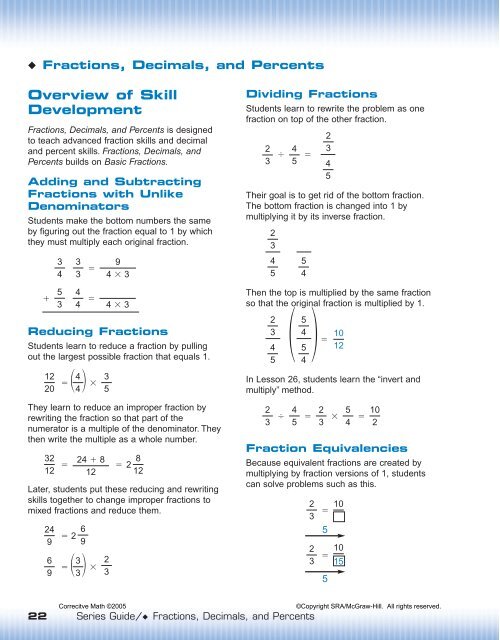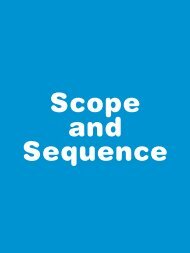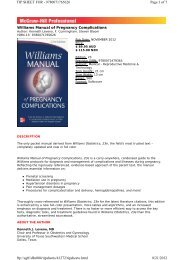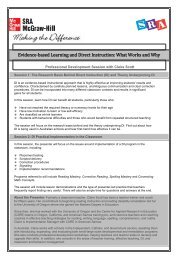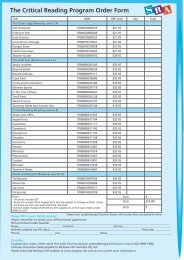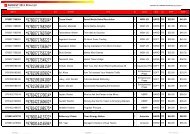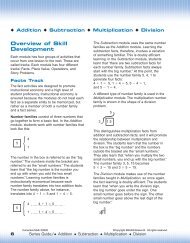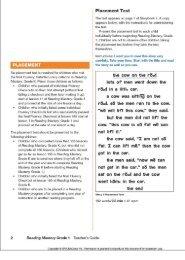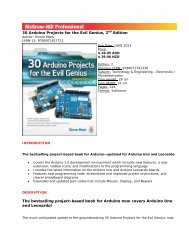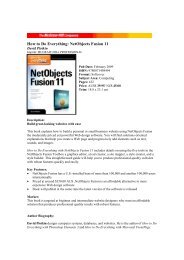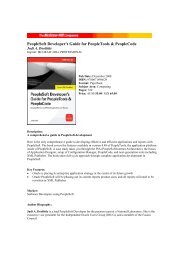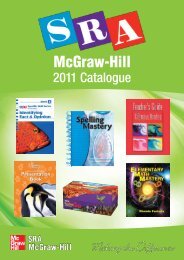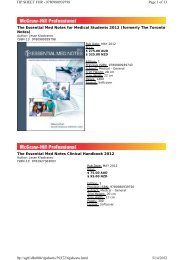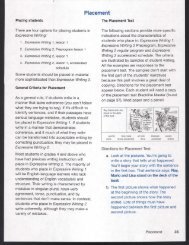Fractions, Decimals, Percents - McGraw-Hill Australia
Fractions, Decimals, Percents - McGraw-Hill Australia
Fractions, Decimals, Percents - McGraw-Hill Australia
You also want an ePaper? Increase the reach of your titles
YUMPU automatically turns print PDFs into web optimized ePapers that Google loves.
◆ <strong>Fractions</strong>, <strong>Decimals</strong>, and <strong>Percents</strong><br />
Overview of Skill<br />
Development<br />
<strong>Fractions</strong>, <strong>Decimals</strong>, and <strong>Percents</strong> is designed<br />
to teach advanced fraction skills and decimal<br />
and percent skills. <strong>Fractions</strong>, <strong>Decimals</strong>, and<br />
<strong>Percents</strong> builds on Basic <strong>Fractions</strong>.<br />
Adding and Subtracting<br />
<strong>Fractions</strong> with Unlike<br />
Denominators<br />
Students make the bottom numbers the same<br />
by figuring out the fraction equal to 1 by which<br />
they must multiply each original fraction.<br />
<br />
5 4<br />
<br />
3 4<br />
Reducing <strong>Fractions</strong><br />
Students learn to reduce a fraction by pulling<br />
out the largest possible fraction that equals 1.<br />
12<br />
20<br />
4<br />
<br />
4<br />
They learn to reduce an improper fraction by<br />
rewriting the fraction so that part of the<br />
numerator is a multiple of the denominator. They<br />
then write the multiple as a whole number.<br />
32<br />
12<br />
24 8 8<br />
2<br />
12 12<br />
Later, students put these reducing and rewriting<br />
skills together to change improper fractions to<br />
mixed fractions and reduce them.<br />
24<br />
9<br />
6<br />
9<br />
3<br />
4<br />
2<br />
3<br />
3<br />
<br />
6<br />
9<br />
<br />
3<br />
5<br />
2 3<br />
3 3<br />
9<br />
4 3<br />
4 3<br />
22 Series Guide/◆ <strong>Fractions</strong>, <strong>Decimals</strong>, and <strong>Percents</strong><br />
Dividing <strong>Fractions</strong><br />
Students learn to rewrite the problem as one<br />
fraction on top of the other fraction.<br />
2<br />
3<br />
4<br />
<br />
5<br />
Their goal is to get rid of the bottom fraction.<br />
The bottom fraction is changed into 1 by<br />
multiplying it by its inverse fraction.<br />
Then the top is multiplied by the same fraction<br />
so that the original fraction is multiplied by 1.<br />
<br />
5<br />
4<br />
<br />
5<br />
4<br />
In Lesson 26, students learn the “invert and<br />
multiply” method.<br />
2<br />
3<br />
2<br />
3<br />
4<br />
5<br />
2<br />
3<br />
4<br />
5<br />
5<br />
4<br />
4 2 5<br />
<br />
5 3 4<br />
Fraction Equivalencies<br />
Because equivalent fractions are created by<br />
multiplying by fraction versions of 1, students<br />
can solve problems such as this.<br />
2<br />
3<br />
2<br />
3<br />
2<br />
3<br />
4<br />
5<br />
<br />
10<br />
12<br />
10<br />
10<br />
15<br />
Correcitve Math ©2005 ©Copyright SRA/<strong>McGraw</strong>-<strong>Hill</strong>. All rights reserved.<br />
5<br />
5<br />
10<br />
2
Decimal Notation<br />
Students learn how to write fractions with<br />
denominators of 10, 100, and 1000 as decimals<br />
and how to write decimals as fractions.<br />
Decimal Expansion<br />
Students learn that adding zeros after the<br />
decimal point does not change the value of<br />
the decimal.<br />
Operations<br />
To add or subtract decimals, students make the<br />
same number of decimal places in each number<br />
and then line up the decimal points.<br />
Scope and Sequence Chart<br />
Students learn to multiply decimal numbers by<br />
10, 100, and 1000 and learn the conventions of<br />
multiplying any two decimal numbers.<br />
First students learn to divide a decimal number<br />
by a whole number. Then students learn to<br />
divide any number by a decimal or a mixed<br />
decimal.<br />
Convert <strong>Fractions</strong> to<br />
<strong>Decimals</strong> to <strong>Percents</strong><br />
Students learn to change any fraction to a<br />
decimal and to handle any type of decimalpercent<br />
conversion.<br />
<strong>Fractions</strong>, <strong>Decimals</strong>, and <strong>Percents</strong><br />
1 5 10 15 20 25 30 35 40 45 50 55 60 65 70<br />
<strong>Fractions</strong><br />
Multiply three numbers: 3(2 5).<br />
Generate equivalent fractions.<br />
Identify the biggest common factor.<br />
Generate a series of fractions equal to 1.<br />
Multiply, add, or subtract fractions and mixed numbers.<br />
Add or subtract fractions with uncommon denominators.<br />
Divide fractions.<br />
Reduce improper fractions to whole or mixed numbers.<br />
Identify the largest fraction in a group of fractions.<br />
Complete fraction equivalency equations.<br />
<strong>Decimals</strong> and <strong>Percents</strong><br />
Read decimals.<br />
Convert fractions and mixed numbers with denominators<br />
of 10 or 100 to decimals.<br />
Convert fractions to decimals and decimals to fractions<br />
with denominators of 10, 100, or 1000.<br />
Convert decimals to fractions.<br />
Expand decimals to show that adding zeros after a decimal<br />
does not change the value of the decimal.<br />
Multiply decimals.<br />
Add decimals.<br />
Divide decimals.<br />
Convert decimals to percents.<br />
Convert percents to decimals.<br />
Key: Teach Review<br />
Correcitve Math ©2005 ©Copyright SRA/<strong>McGraw</strong>-<strong>Hill</strong>. All rights reserved.<br />
Series Guide/◆ <strong>Fractions</strong>, <strong>Decimals</strong>, and <strong>Percents</strong> 23


